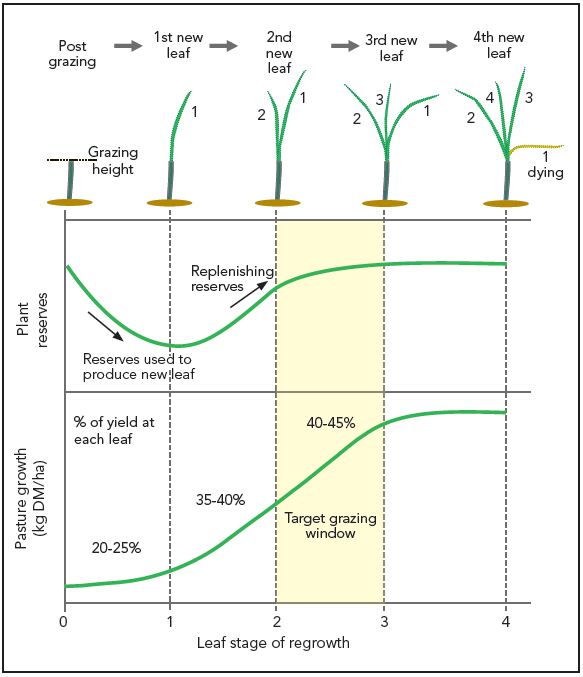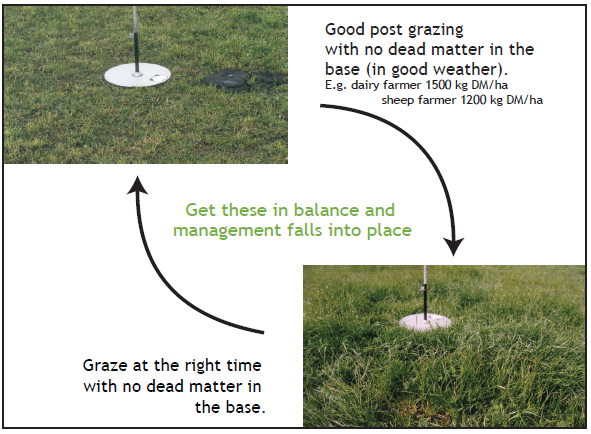Principles of ryegrass growth
Keeping pasture cover within the optimal range helps achieve high growth rates, high utilisation, and high pasture quality.
The correct time to graze ryegrass is when there are 2.5-3 leaves per tiller. For rapid regrowth after grazing, keep post-grazing residuals above 5 cm or 1500 kg DM/ha for dairy or cattle systems, and 3 cm or1200 kg DM/ha for sheep systems.
Ryegrass plant
Perennial ryegrass pasture is made up of many ryegrass tillers. Tillers are found grouped together in clumps, each clump forming a ryegrass plant.
Dairy pastures typically contain 3000-5000 tillers per square metre while sheep pastures contain 8000 or more.
New tillers are produced year-round with peak production usually from October to December. This is why late spring pasture management strongly influences persistence.
Ryegrass tiller
A tiller has a single basal stem, a leaf sheath and a number of leaves. It can have only three green growing leaves at any time.
When the tiller has three leaves it doesn’t stop growing. A fourth (new) leaf is produced, and the first (oldest) leaf starts to die.
Then a fifth leaf is produced, the second leaf dies, and so on. If pasture isn’t grazed, dead older leaves (of little feed value) build up in the base of the pasture.

How quickly do leaves grow?
The time it takes for a tiller to produce a new leaf varies, and depends largely on temperature (in winter) or moisture (in summer). In mid-spring a new leaf may be produced every 8 days while in mid-winter it may be every 17 days.
Tiller growth & yield
As a tiller regrows (as shown below) the initial growth rate is slow, and the first new leaf makes up only 20-25% of the potential yield of a pasture. Growth accelerates with the second leaf, and further with the third leaf. Simply put, the tiller is moving from one 'solar panel' or leaf to 3. Grazing at 3 leaves per tiller captures most of this growth, with the third leaf producing 40-45% of potential yield.
Re-growth & energy reserves
Mostly we sow diploid ryegrass-based pastures and graze them at the 2 - 2.5 leaf stage because this is the easiest way to maintain good residuals. Tetraploid ryegrass-based pastures can change this, because they remain palatable at higher covers. At the Lincoln University Dairy Farm grazing 0.5 leaves/tiller later (at 3500-3600 kg DM/ha) grew around +1.2 t DM/ha/year.
The regrowth cycle initially relies on the energy reserves plants store as carbohydrate in the basal stems. Immediately after grazing plants rely on these to provide energy for regrowth until the first new leaf is produced (see middle diagram). With the first new leaf, photosynthesis then becomes the main energy source for growth of subsequent leaves as well as replenishing carbohydrate reserve stores.
Regrowth, energy reserves & yield per leaf

Grazing
Ryegrass does best under a consistent cycle of grazing, as summarised below.

When to graze
The optimal time to graze pastures to achieve both high growth rates and high pasture quality is when tillers show an average of 2.5-3 leaves. To assess this, check several tillers in a pasture, as they vary. (Ignore older leaves left over from the last grazing). At the correct stage, tillers will have a third leaf, varying from half to fully developed.
Grazing too early
Grazing before or at 2 leaves per tiller reduces both yield and regrowth as it does not allow plant reserves to be fully restored (see page 100). This is particularly important after extended summer dry periods, when plants are under stress. Nipping off the first leaf growth after rain, before tillers have 2.5-3 new leaves, can kill plants.
Grazing too late
If a pasture is left to grow too long (>3500 kg DM/ha) it continues to produce new leaves, but older leaves die off. Dying leaves accumulate in the base of the pasture. These reduce pasture quality, lower pasture utilisation and can cause disease. Long or dying pasture creates a favourable environment for pests, diseases and fungal spores (e.g. rust, facial eczema). High covers (>3,500kg DM/ha) also compromise your clover growth because not enough light reaches the base of the pasture.
Grazing too late usually happens in periods of rapid growth, when multiple paddocks are ready to graze simultaneously. Monitor growth; if necessary remove paddocks from grazing to cut for supplementary feed, or pre-graze or post-graze mow.
Grazing too low
Grazing below normal residual height can significantly reduce regrowth and animal performance, as you are grazing into the plant energy reserves. Graze to the same height each time.
Consistency
The secret to good grazing management is keeping pastures in the right 'grazing window' - maintaining consistent post-grazing residuals, and grazing at the right time.

